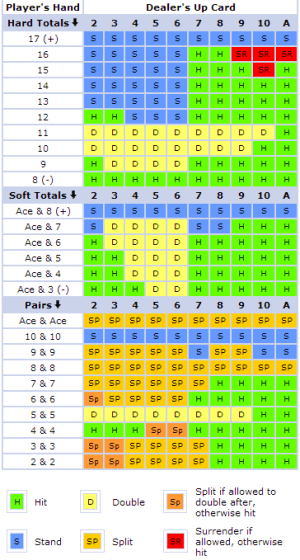High Low Method Blackjack
The high-low pickup: Another method of stacking or setting the deck is to pick up cards in a round in alternates of high and low cards. A savvy (and sketchy) dealer will have developed a fake shuffle move that keeps the cards in the order the dealer picked them up. The Hi-Lo (High Low) system is one of the easier and more popular card counting systems for blackjack. The Hi-Low consists of assigning a point value of +1, 0, or -1 to every card dealt to the player. Each card is assigned a specific point value in the Hi Lo System. Aces and 10-point cards are assigned a value of -1. Hi-Lo Count Blackjack Strategy One of the most popular, and easiest blackjack card counting strategy is the Hi-Lo Count, the reason this strategy is so popular is that it is simple to learn and easy to implement. Each card in the deck is given a value of either -1, +1 or 0. The total value of a 52 card deck is zero. The method for assigning point values to cards varies based on the system. However, the general idea involves adding +1, 0, or -1 to specific card groups. The popular Hi-Lo system includes the following point values and card groups: High cards (10 through ace) = -1; Neutral cards (7 through 9) = 0; Low cards (2 through 6) = +1. High Low Method Blackjack, casino flash php script v 2.0, vostro 260 memory slots, dolphin quest slot machine.

Card Counting Systems > Speed Count
Dan Pronovost, gambling teacher and creator of several gambling tactics, came up with Speed Count as an answer to a friendly question. When asked if there was an easier way for the average gambler to count cards and gain an edge over the casino, Dan came up with Speed Count.
Dan and his friend noticed that most gamblers needed as much as 80 hours of training before learning even the most basic High-Low counting system, and that in reality only a small percentage of gamblers could put a High-Low count into practice effectively. The Speed Count method was Dan’s answer to this problem.
Editor’s Picks for Best Online Blackjack in 2020
- Multiple blackjack games
- Publicly traded company
- Multi award winner
- RTG Blackjack
- ViG Live Blackjack
- BTC Bonuses
- Live Dealer Blackjack
- 24/7 Live Support
- Trusted since 2007
High Low Method Blackjack Card Game
- Online and mobile blackjack
- Great for U.S. based players
- New and fresh
High Low Method Blackjack Free
The Basics of the Speed Count
Blackjack writers tell us that the average hand of blackjack is 2.7 cards, meaning more people take three cards than two. Since there are just 5 “small” cards for every 13 “big” cards in a 52-card deck, we get an average of 1.03 “small” cards for every hand of blackjack played–about one card per hand, regardless of how many people are playing, how many decks are in play, etc.
Using this number, you have all you need to build the Speed Count method. Simply count all the “small” cards on the table as “+1” and at the end of each round, subtract the total number of hands dealt. This includes split hands. As your count gets higher, there are fewer “small” cards in the deck, giving you an advantage.
How Much of an Edge does the Speed Count Offer?
According to an independent audit by the University of Massachusetts, the Speed Count produced a player edge of just over 1% over the course of a billion rounds of blackjack. This is about three times better than the expectation afforded blackjack players who play according to perfect strategy, and the method is even easier to implement than basic blackjack strategy.

Speed Count requires an understanding of basic blackjack strategy so that you know how to properly play most gaming situations, but since casinos allow you to carry your strategy card with you to the blackjack table, the creators of the Speed Count method seem to put little emphasis on learning this strategy. Instead, they encourage people who want to learn Speed Count to shell out hundreds of bucks for a two-day seminar, and if red flags are going up for you, you’re not alone.
The fact that you have to take a seminar to learn the ins and outs of Speed Count mean that most people won’t both. If I have to buy a book or take a high-priced seminar to learn something, I’d rather not learn it at all.
The inventors of Speed Count have done a great job keeping the details of this method secret. But from the presentation of an independent audit and a few details of the counting system, it looks like it would work to some degree. The inventor of the Speed Count has admitted openly that more complex counting systems, like KO, offer a better advantage, but suggests that most people won’t ever be able to learn these more difficult systems, so a system like Speed Count is ideal for people without 80 or 120 hours to learn harder card counting methods.
Speed Count is one of many new card counting methods aimed at people who’ve had trouble memorizing card counting tactics in the past. If you want to learn more about Speed Count, you’ll have to contact the company that owns the license. Be careful paying for any card counting method that doesn’t reveal more details than a few cursory lessons and a mathematical audit–you may serve yourself better learning one of the higher level counting systems that take a little bit of time to perfect.